When it comes to keeping your house in Northeast Georgia safe and healthy, understanding how to spot and manage mold is crucial. As residents in an area that often experiences high humidity levels, we’re all too familiar with the potential for mold growth in our homes. The trick isn’t just in tackling mold after it appears—but in regularly inspecting and stopping mold before it becomes a major headache.
Mold isn’t just a minor nuisance; it can impact the air quality of your home and potentially lead to health issues for you and your family if left unchecked. That’s why we’ve put together a straightforward guide to help you conduct a thorough mold inspection yourself. Taking this proactive approach ensures that you keep your living environment fresh and safe. Plus, it’s satisfying to know that you can manage these inspections on your own, giving you peace of mind that you’re doing everything possible to protect your home from unwanted fungal guests. With the right tools and knowledge, you’ll be able to identify potential problems early and address them efficiently.
Why Regular Mold Inspections Are Crucial for Your Northeast Georgia Home
Keeping our homes in Northeast Georgia safe and mold-free is a priority for all of us. Due to the area’s high humidity throughout the year, our homes are particularly susceptible to mold growth. This is why conducting regular mold inspections is not just a preventive measure—it’s an essential practice to maintain a healthy living environment. Regular checks help us identify potential mold outbreaks before they escalate and cause more serious health problems or structural damage to our homes.
How often should we check for mold? At least twice a year. Moreover, after any event that introduces moisture into our homes, like severe rainfall or flooding, it’s crucial to inspect for mold. These consistent checks not only help in early detection but also in managing the air quality of our homes, ensuring that we and our families are breathing clean, safe air. By being proactive about mold inspections, we reduce the likelihood of extensive mold issues, which can be both costly and harmful to remediate later on.
Essential Tools for Conducting a DIY Mold Inspection
Embarking on a DIY mold inspection might sound daunting, but with the right tools, it’s something we can all handle effectively. Here is a handy list of essential items that we should have in our mold inspection kit:
1. Flashlight: A good quality flashlight will help us see into dark nooks and crawl spaces where mold likes to hide.
2. Inspection Mirror: This tool comes in handy for checking hard-to-view areas, ensuring we don’t miss any hidden mold growth.
3. Moisture Meter: This is crucial for detecting moisture levels in walls, floors, and ceilings. Higher moisture content is a potential harbinger of mold.
4. Protective Gear: Safety first! Gloves, goggles, and a mask will protect us from direct contact with harmful mold spores.
5. Camera or Smartphone: Taking pictures of affected areas can be helpful for documenting the extent of mold growth and for future reference or expert consultations.
6. Notebook and Pen: Keep track of findings for each room inspected. This record-keeping will be essential in monitoring areas over time and in communicating any necessary interventions.
With these tools ready, we’re all set to thoroughly inspect our homes and tackle any signs of mold promptly. Knowing what to use and how to use it empowers us to effectively manage our home’s health, keeping our living spaces safer and more comfortable.
Step-by-Step Guide To Inspecting Different Areas of Your Home for Mold
Inspecting our homes for mold involves a systematic approach to ensure no area is overlooked. We start from the most common areas where moisture accumulates, such as bathrooms and kitchens, and then move to less obvious places like attics, basements, and crawl spaces, which are typical mold hotspots due to their lower traffic and higher humidity levels.
We begin with visible checks around water sources—sink cabinets, behind toilets, and under refrigerators. Next, we use our moisture meter to check the walls and floors around these areas for any hidden dampness. The attic and basement require a thorough inspection of the insulation and wooden beams, as these materials can host mold if exposed to moisture. Don’t forget the HVAC system; the ductwork can accumulate moisture and dust, creating a breeding ground for mold.
With each area, we document our findings, photographing any signs of mold or moisture for future reference, ensuring that nothing is missed. This meticulous approach helps us tackle potential issues head-on, maintaining our home’s air quality and integrity.
What To Do if You Find Mold: Safe Cleanup Tips and When To Call the Pros
Finding mold can be unsettling, but it’s important to address it promptly to mitigate any risks to our health or home. Small areas of mold, typically less than 10 square feet, in its beginning stages can be handled by the homeowner following safety protocols. Wear gloves, goggles, and masks for protection, and then scrub the mold away with soap and water or a vinegar solution. It’s crucial to ensure the area is thoroughly dried after cleaning, preventing any future growth.
However, for larger infestations or if the mold comes back after the initial cleanup, it’s time to call in the professionals. These experts have the tools and training to safely remove pervasive mold, especially in hard-to-reach areas or when dealing with dangerous types like black mold. By calling in the pros from a dedicated team like Sentry Restoration, we ensure your home is not only clean but also safe from potential mold-related problems in the future.
Conclusion
Mold in your home can be a serious concern, but with regular inspections and the right approach to cleaning and prevention, you can manage this risk effectively. Keeping your living spaces safe and healthy is our priority, and understanding how to handle mold gives you the confidence to protect your home and family.
If you’ve tackled mold on your own but are seeing persistent issues or large-scale growth, don’t hesitate to reach out for professional and affordable mold remediation solutions. Contact Sentry Restoration today, and let us take care of keeping your Northeast Georgia home mold-free and healthy for years to come.



